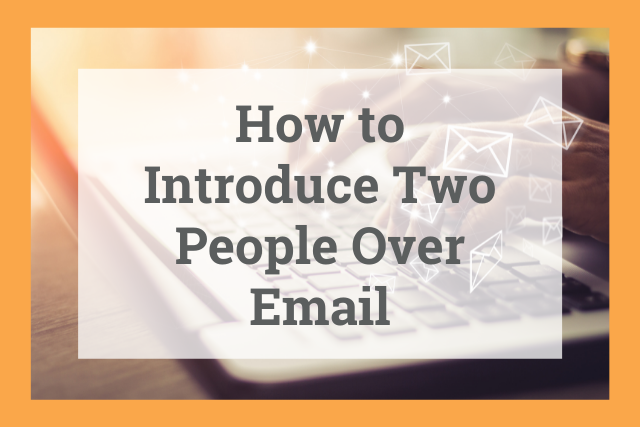
When you know two people you think should meet, how do you introduce them?
Email is the simplest way to introduce two people, but you should be aware of email etiquette.
Today, we're telling you everything you need to know about introducing two people through email.
Ask Permission Before Introducing Someone in an Email
No one wants to feel obligated to talk to someone they don't want to meet at the moment.
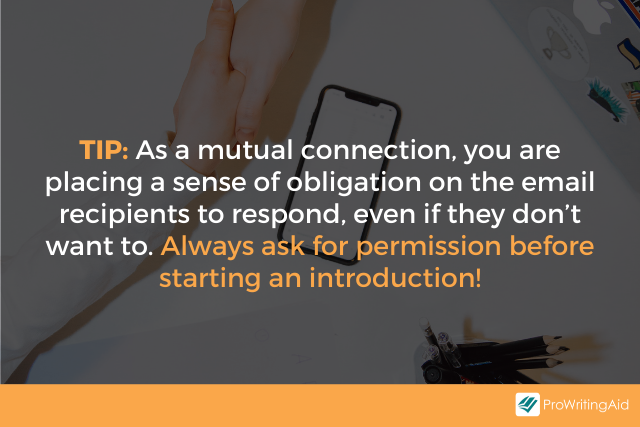
As a mutual connection, you are placing a sense of obligation on each person you're introducing. This is why it's important to obtain consent from both parties before you introduce them over email.
In some cases, one party may have asked you to introduce them to the other person. You still need to get permission from the person they want to meet.
Other times, it may be your idea to introduce them to each other. You'll need permission from both of them. This is called a double opt-in introduction.
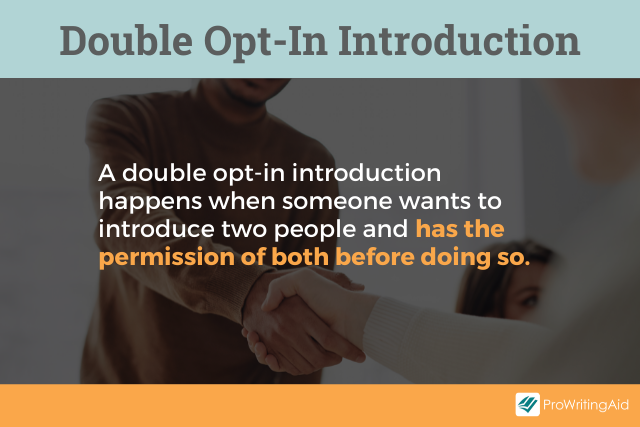
Sometimes, getting this permission happens informally in conversation. If not, email each person separately. Tell each of them why you think they should meet and how you are acquainted. Keep it brief.
Wait for a positive response from both parties before making the email introduction. Once they give you the green light, you're ready to write the introductory email using the six steps below.
How to Introduce People via Email: 6 Steps
Every introductory email will be slightly different, depending on your relationship with each party and why you are introducing them. But the general process for how to introduce two people over email is the same.
We've broken this process down into six easy steps.
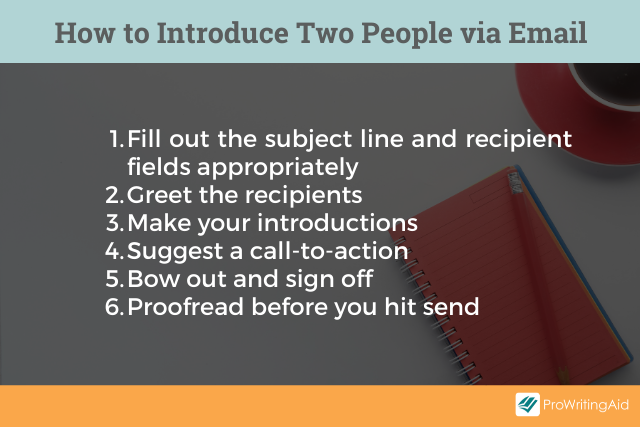
1. Fill out the Subject Line and Recipient Fields Appropriately
The recipient fields in email are To, CC, and BCC. When introducing two people over email, you will typically use To and CC. In some cases, you can even choose to ignore CC all together.
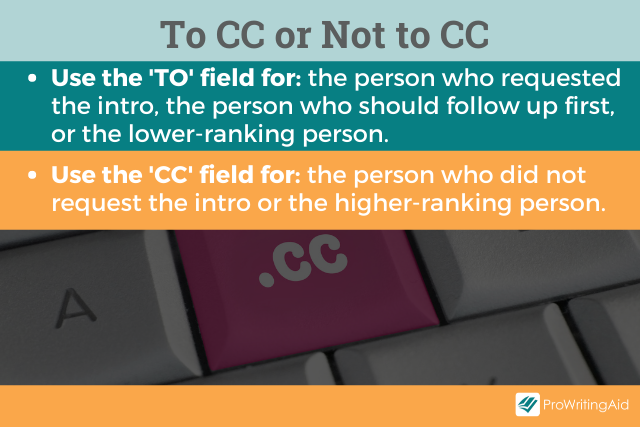
If Person A asked you to make the connection, their email will go in the To field. The person they want to meet will go in the CC field.
If it was your idea to introduce them, you can place both of them in the To field. However, if you're introducing two people of different rank, for example, someone applying for a job and the boss of the company, put the higher-ranked person in the CC line. This puts the onus of who should follow up first on the lower-ranked person.
The subject line should be brief. Last names aren't necessary unless they share a first name. If they work for two different companies, and you're emailing to facilitate a collaboration, you can include the business name in parentheses. This will help them to remember why you are emailing.
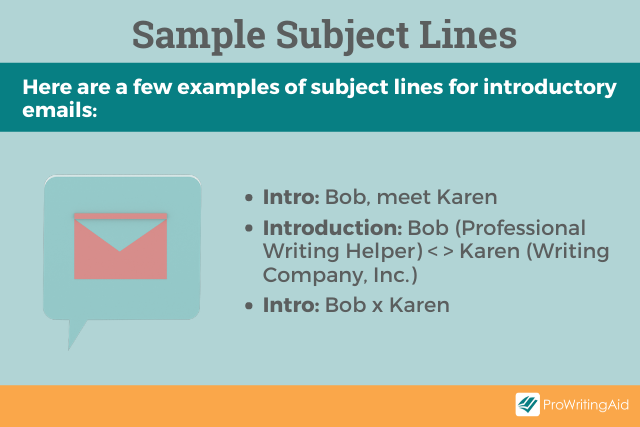
Say something about an "intro" or "introduction." Here are a few examples of subject lines for introductory emails.
- Intro: Bob, meet Karen
- Introduction: Bob (Professional Writing Helper) > Karen (Writing Company, Inc.)
- Intro: Bob x Karen
That's it! Short and sweet is the best option when writing a subject line.
Greet the Recipients
There are a couple of ways to greet two people over email. If the introduction was your idea, you can greet both of them in the opening. But if one outranks the other, or you utilized the CC field, you should address it to whoever is in the "To" field. If Person A asked for the introduction, address the salutation to them.
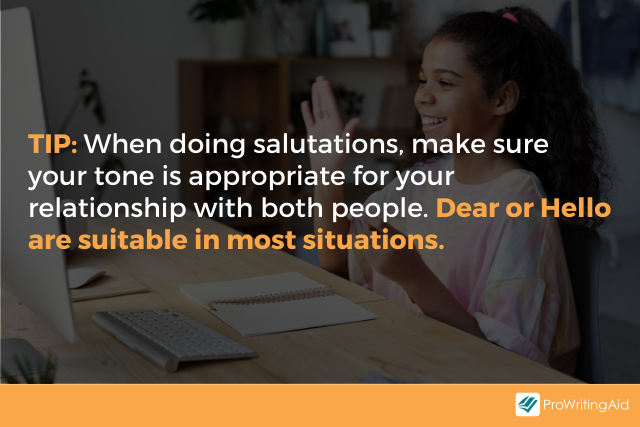
Keep your salutation short and sweet and make sure your tone is appropriate for your relationship with both people. In other words, don't use "hey" if you aren't on casual terms with both people. "Hi" or "Hello" are both appropriate for most situations.
After the salutation, offer a nice opening sentence that addresses both of them. Here are some ways you might open your email.
- I hope this week is treating you both well.
- I hope you're both doing well.
- I'm excited to introduce you to each other.
- Thanks for agreeing to this introduction.
One sentence is plenty. Once you've made your greetings, you can now make your introductions.
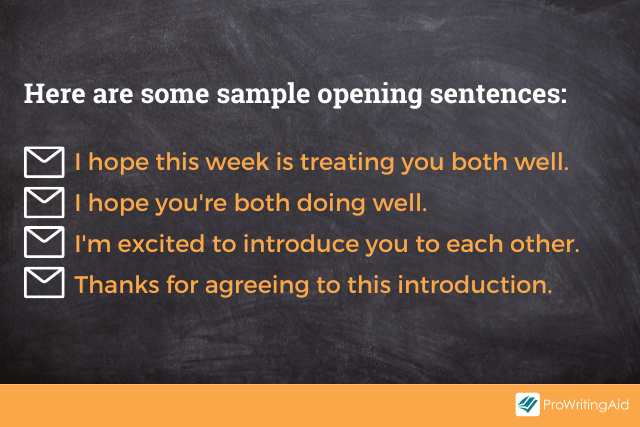
Make Your Introductions
When you introduce two people over email, there are three things you need to mention about both of them:
- Who they are
- How you know them
- Why they should meet
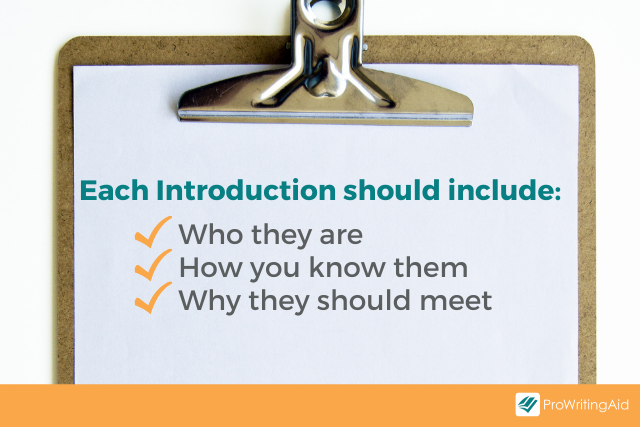
Let's return to our example of Bob and Karen and start building an introductory email.
Hi Bob,
Thanks to both of you for agreeing to this introduction. Bob, I'd like you to meet Karen, whom I mentioned in our meeting. Karen is a developer at Writing Company, Inc. and she is a pro at NLP. We worked together for several years at Writers Who Write, and I can't say enough good things about her work ethic. I think she'd be a great fit for our team.
Karen, Bob is my boss at Professional Writing Helper. He's passionate about writing technology just like you. Bob is looking for a new developer who knows both writing tech and NLP. I thought of you, and he asked to meet you.
It's always a good idea to include a compliment when you're introducing two people. It makes them, and you, look good.
Suggest a Call-to-Action
Your introduction has a purpose. What do you want the recipients to do now that you've introduced them?
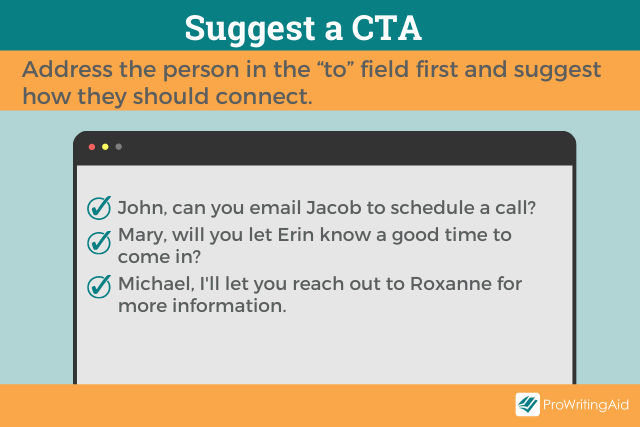
If you aren't sure what the next step should be, your call-to-action can be as simple as, "I'll let you take it from here." You could also suggest a more specific call-to-action. You might suggest they connect to meet up for coffee or schedule a call or appointment.
Remember, the person who requested the introduction email, or the person in the "To" field (these might be the same person), has the onus of following up. However, they might not be aware of this email etiquette. Name the person who should follow up when suggesting a CTA.
Here are some suggestions for CTAs when you introduce two people over email:
- John, can you email Jacob to schedule a call?
- Mary, will you let Erin know a good time to come in?
- Michael, I'll let you reach out to Roxanne for more information.
We'll return to our Bob and Karen example in the next section, so you can see the ending of an email in action.
Bow Out and Sign Off
Once you've made the introduction, it's time for the two people to get to know each other. In most situations, you will want to be taken off the email thread. No one wants an inbox full of emails that don't apply to them.
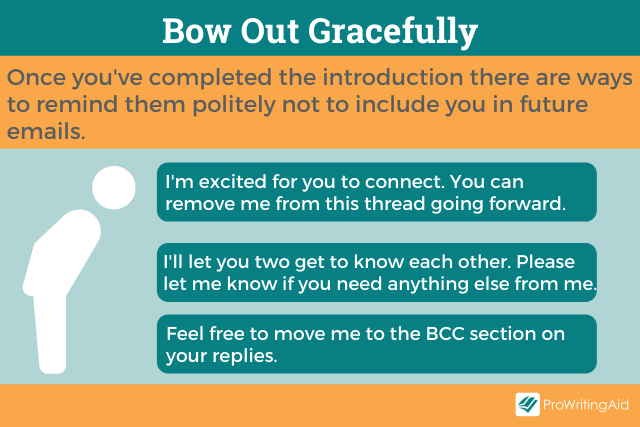
Often, people will know to do this, particularly if you're introducing a hiring manager to a potential job applicant. But there are ways to remind them politely not to include you in future emails. If you do need or want to be included, you can also ask them to move you to the "BCC" field for the next email. This will give them the opportunity to thank you for the introduction.
Let's check out some ways you can bow out of an email introduction thread.
- I'm excited for you to connect. You can remove me from this thread going forward.
- I'll let you two get to know each other. Please let me know if you need anything else from me.
- Feel free to move me to the BCC section on your replies.
Your sign off should feel natural and be appropriate to your relationship with both parties. If you have a very formal relationship with one and a less formal relationship with the other, choose something neutral but warm, such as “all the best,” “warmest regards,” “thanks again,” or “best wishes.”
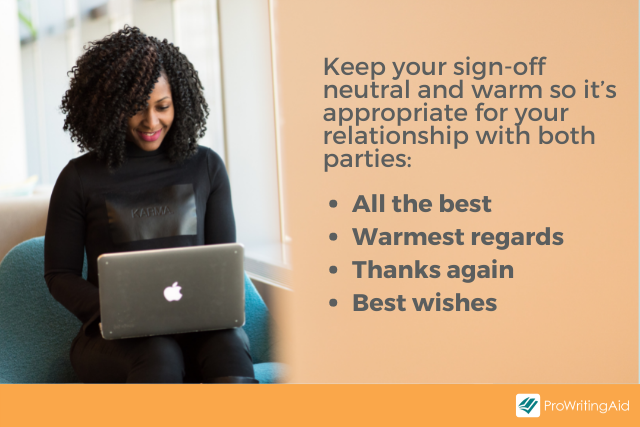
Let's go back to our example of Bob and Karen. This is how you might suggest a call-to-action, bow out, and sign off.
Bob, I'll let you reach out to Karen to chat about the position. Let me know if either of you need anything else from me.
All the best,
Belinda
As you can see, you don't need to have a fancy conclusion. Aim to be succinct, clear, and polite.
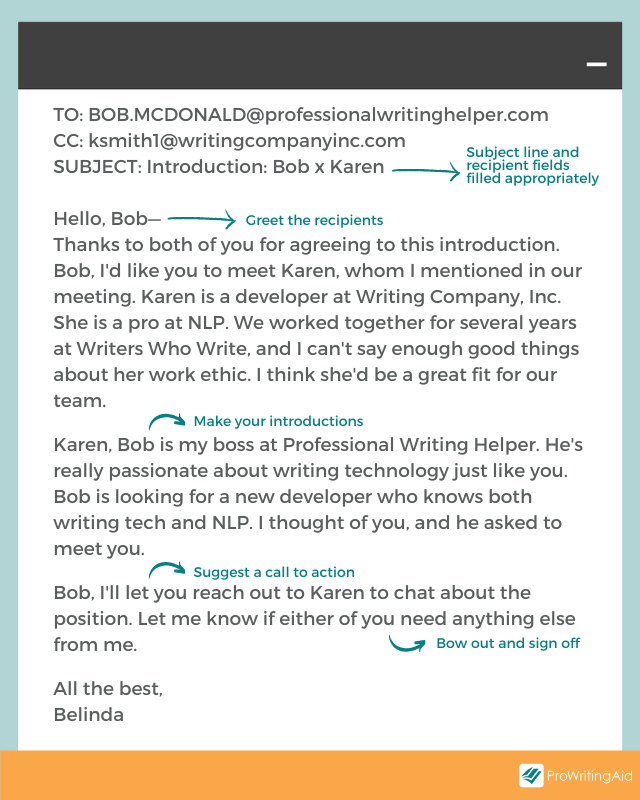
Proofread Before You Hit Send
Once you have drafted your email, it's time to proofread. First, make sure that both email addresses are typed correctly. You don't want to accidentally introduce Bob to "ksmith@emailprovider.com" when you should have emailed "ksmith1."
Then, check that you've attached any necessary documents that you mentioned in your email. This isn't common for email introductions, but it is a possibility. You also want to be certain that you have spelled both parties names correctly throughout the email.
Finally, check your spelling and grammar using a free grammar checker like ProWritingAid to be sure your writing is clean and coherent.
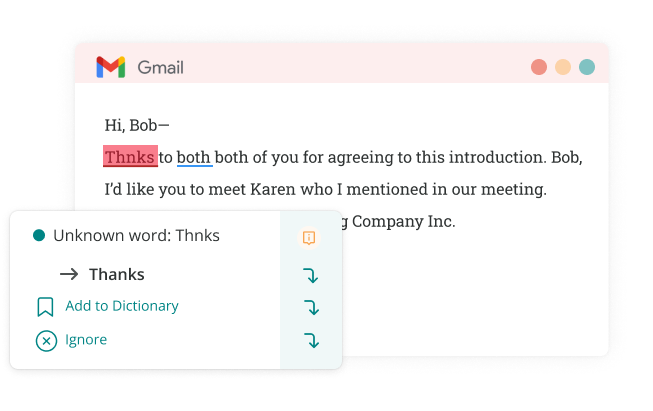
Start creating professional emails with a free ProWritingAid account
Two-Way Email Introduction Samples
Let's check out two more examples of how to introduce two people over email. This first one is more informal than Bob and Karen’s.
TO: Maria.Lopez@emailprovider.com, JuliaSmith@JuliaSmith.Com
SUBJECT: Intro: Maria, meet Julia.
Good morning, Maria and Julia!
I'm excited to connect both of you. Maria, Julia is the graphic designer I was telling you about. She's done some great work for some big-name clients. I know her through my volleyball club. She knows a lot about getting started in graphic design, which I know you're interested in.
Julia, Maria is a talented artist who is considering pursuing a degree in graphic design. She's my best friend's little sister. It would be great if you could answer some of her questions about the field.
Maria, you can email Julia some of the questions you have. Feel free to remove me from this email thread.
All the best,
Shauna
Let's take a look at another example connecting two people from different companies.
TO: BradM@genericHVACcompany.com
CC: JanetMatthews@hvacpeople.com
SUBJECT: Introduction Brad < > Janet
Hi, Brad,
I hope you're both doing well this week. Brad, I'd like to introduce you to Janet Matthews. She's the HVAC engineer I told you about who has worked in castles and other historic buildings before. We went to school together. I thought she could be a good resource for that Transylvanian castle project you're working on.
Janet, Brad has installed hundreds of HVAC systems before, including the one for my office. He's working on an interesting castle where a scientist lives and could use your expertise.
Brad, can you email Janet to set up a time to talk shop? Please remove me from the thread—I know nothing about HVAC!
Warmest regards,
Eddie
Introducing two people via email doesn't have to be awkward or stressful. Just follow our six steps to success to facilitate seamless connections through email.
Want to learn more great business writing hacks? Download this free book now:
Business Writing Hacks for Flawless Communication
Writing is an essential element of nearly every profession today. Strong communications help colleagues and clients understand your ideas. Errors and awkward writing make you lose credibility.
Download this guide to learn the techniques professional writers use to write clearly and persuasively.
eBook 8 CTA - ProWritingAid in the Classroom



